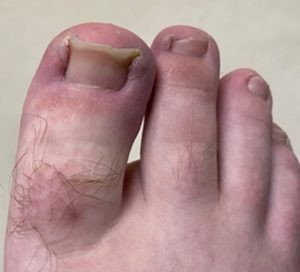Ingrown Toenails
- Foot & Ankle Center

- Nov 10, 2022
- 2 min read
Updated: Apr 4

Dr. Jesseka Kaldenberg-Leppert
Ingrown toenails are a painful yet common issue affecting the feet and ankles. They can arise from various factors, including toenail fungus, hereditary nail shapes, nail deformities, and trauma. When an ingrown toenail develops, the nail grows downward into the surrounding skin instead of outward, leading to the nail cutting into the skin. This can create an entry point for bacteria, increasing the risk of infection. Symptoms typically include pain, redness, drainage, and swelling, with the most common occurrence being on either side of the big toe.
At the Foot and Ankle Center of Iowa, your foot and ankle specialists will begin with a consultation to examine your foot and the ingrown toenail. Depending on the severity of the infection, your foot doctor may recommend x-rays. These images help determine whether the infection has spread to deeper soft tissues or the bone. Your doctor will review the x-ray results with you and discuss various treatment options, which may include antibiotics or procedures to remove the ingrown nail.
Treatment Options for Ingrown Toenails
There are several procedures that can be performed to treat ingrown toenails. Your foot and ankle doctor will discuss these options with you and develop a treatment plan tailored to your needs. The following procedures may be considered:
Nail Avulsion: In this procedure, the doctor will numb your toe with a local anesthetic. Once the area is numb, the doctor will remove the entire toenail or the affected edges, allowing the nail to regrow over several months. During this regrowth period, your foot doctor may recommend antifungal medications.
Matrixectomy: Similar to the nail avulsion, your foot doctor will numb your toe with a local anesthetic. However, in this case, the doctor will remove the entire toenail or the affected edges and apply a chemical to destroy the nail bed, preventing the toenail from regrowing. This is a permanent solution.
Prevention Tips for Ingrown Toenails
To help prevent ingrown toenails, consider the following tips:
Cut nails straight across to avoid ingrowth.
Avoid “bathroom surgery”: Do not attempt to remove an ingrown toenail yourself, as this can lead to increased pain and a higher risk of infection.
If you notice swelling, redness, warmth, or drainage from an ingrown toenail, apply antibiotic ointment and a bandage, and contact your foot and ankle doctor.
For further assistance, contact the Foot & Ankle Center of Iowa to schedule an appointment and discuss your foot and ankle concerns.



Comentarios